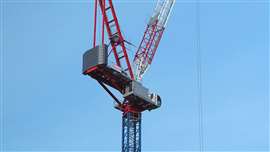First Sáez luffing jib tower on site in UK
26 October 2023
UK-based tower crane rental company Bennetts Cranes has provided the first Sáez SL 730 luffing jib tower crane in the UK to Camden Goods Yard, to support the lifting of precast concrete frames.
 The Sáez SL 730 is the newest and largest luffing jib model in the Sáez tower crane fleet. (Photo: Bennetts Cranes)
The Sáez SL 730 is the newest and largest luffing jib model in the Sáez tower crane fleet. (Photo: Bennetts Cranes)
The eight acre site will see construction of several luxury homes, workspaces, shops, and cafes.
As well as the Sáez SL 730, Bennetts provided the site with a Raimondi LR213 and two Jost 316s luffing jib tower cranes.
Camden Goods Yard required the use of multiple crane hooks in a limited footprint. As the site is next to a railway line, all cranes had to meet Network Rail requirements.
Luffing jib cranes were supplied because, unlike saddle jib cranes, several luffing jib cranes can be placed close together, maximising the speed of construction and productivity, the company said.
New crane
The Sáez SL 730 is the newest and largest luffing jib model in the Sáez tower crane fleet.
The crane has a maximum lifting capacity of 36 tonnes at a radius of 25 metres. It can be configured with jib lengths from 35 to 70 metres depending on site requirements.
“Building with precast concrete is highly efficient but it does require careful planning when it comes to specifying the lifting solution to make the most of these efficiencies. We recommended the Sáez SL 730 for Camden Goods Yard due to its high load capacity of up to 36 tonnes which meant the concrete frame could be built on a tight programme,” said Edward Seager, managing director at Bennetts Cranes.
Precast construction
Precast concrete panels for construction projects are becoming increasingly popular, Bennetts said. With the panels being manufactured off-site, it significantly reduces the time required for on-site assembly. There is also less lifting and moving of materials, creating a safer work environment with fewer hazards. Plus, assembling the panels off-site reduces on-site waste and can be more environmentally friendly.
Bennetts said even though high-capacity cranes are more expensive to hire, they usually outweigh the cost savings of hiring the crane (or cranes) for less time. Once the crane is on-site and the precast panels are supplied, it is a quicker process to lift the panels into place.
The Sáez SL 730 is expected to be on site for 98 weeks and is estimated to be dismantled in August 2024.
STAY CONNECTED


Receive the information you need when you need it through our world-leading magazines, newsletters and daily briefings.




